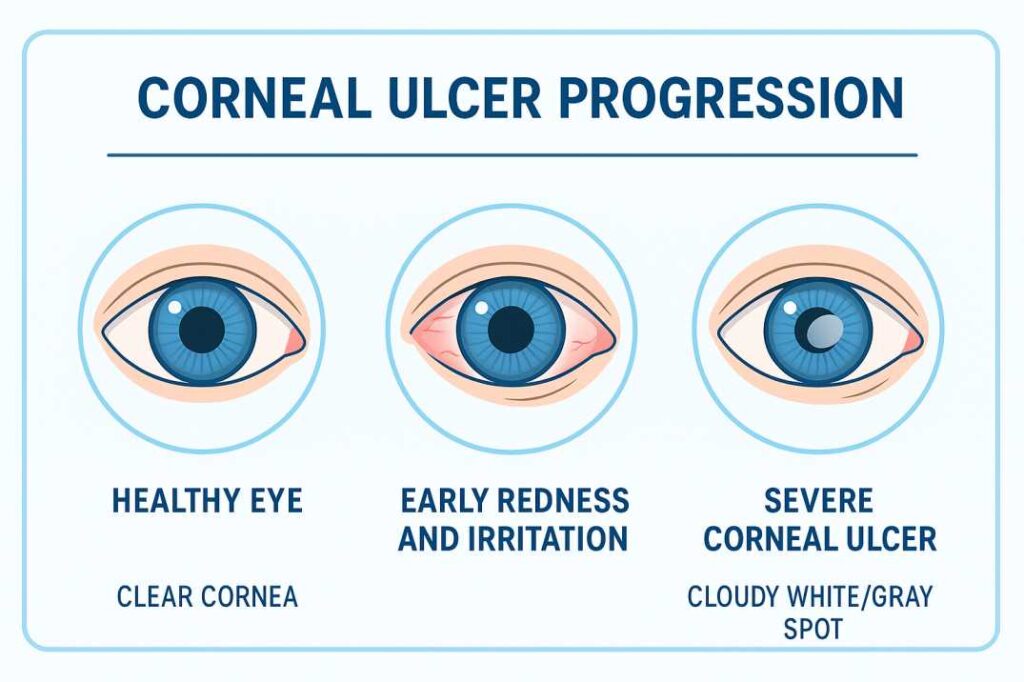Corneal Ulcer
Understanding Corneal Ulcers: Urgent Eye Care in Seattle
A corneal ulcer is an open sore on your cornea—the clear, dome-shaped “window” covering your eye’s front surface. These vision-threatening wounds range from tiny lesions to large defects requiring emergency treatment.
At Cannon EyeCare in Seattle, we see these ulcers frequently due to our humid climate and the tech-sector population’s high contact lens use. Contact lens wearers are 10-15x more likely to develop ulcers, contributing to ~30,000 U.S. cases annually.
Key Facts for Seattle Residents:
-
Primary Cause: Bacterial infections (often from improper contact lens hygiene)
-
Critical Risk: Permanent vision loss without immediate care
-
Action Required: Seek emergency optometry services promptly
-
Healing Timeline: Days to weeks, depending on severity
Recognizing Corneal Ulcer Symptoms: Seattle Emergency Care Guide
Corneal ulcer symptoms escalate rapidly and demand immediate attention. At Cannon EyeCare, we see these urgent cases frequently across Seattle—here are critical signs based on our clinic and local ER reports:
Early Symptoms in Seattle Patients:
-
Severe eye pain intensifying with blinking
-
Persistent sensation of a foreign object in the eye
-
Excessive tearing or unusual discharge
-
Light sensitivity (photophobia)
-
Sudden blurred or decreased vision
-
Pronounced red or bloodshot appearance
Symptom Progression Timeline:
- Hours 1-6: Discomfort begins, mild redness, slight vision blur
- Hours 6-24: Sharp pain increases, discharge thickens, severe light sensitivity
- Days 2-3: Dramatic vision decline, visible white/gray spot on cornea
- Beyond 72 hours: High risk of permanent scarring and vision loss
Seek Emergency Care at Our Seattle Clinic If You Experience:
-
Suddenly, debilitating eye pain
-
Rapid vision deterioration
-
Thick yellow/green discharge
-
Visible white or gray spot on the cornea
-
Inability to open the eye due to pain
What Causes Corneal Ulcers? Seattle-Specific Risk Factors
Contact lens complications are the leading cause of corneal ulcers in Seattle. At Cannon EyeCare, we identify these high-risk behaviors through local case analysis:
Avoid These Contact Lens Habits:
-
Sleeping in daily/weekly lenses
-
Cleaning lenses with tap water
-
Infrequent lens case replacement
-
Swimming or showering while wearing lenses
-
Extending lens wear beyond the prescribed duration
Seattle-Enhanced Risks:
-
High humidity promotes bacterial growth
-
Outdoor activities (hiking, water sports) increase contamination exposure
-
Prolonged screen time reduces blink rates and causes dry eyes
Infectious Causes in Seattle:
Bacterial Infections (Most Common):
-
Pseudomonas aeruginosa: Aggressive, rapid-spreading
-
Staphylococcus aureus: Often antibiotic-resistant
-
Streptococcus: Prevalent in children and seniors
Fungal Infections:
-
Thrive in Seattle’s humidity
-
Frequently from soil or plant exposure
-
Require specialized antifungal treatment
Viral Infections:
-
Herpes simplex virus (recurrent, needing long-term care)
Medical Conditions Increasing Risk:
-
Dry eye syndrome (common in Seattle’s tech workforce)
-
Diabetes mellitus (impairs healing)
-
Autoimmune disorders (lupus, rheumatoid arthritis)
-
Prior eye injuries or surgeries
Corneal Ulcer Risk in Seattle: Who Needs Urgent Eye Care?
Cannon EyeCare’s patient data reveals distinct corneal ulcer risk patterns among Seattle residents. If you fall into these groups, prioritize regular eye evaluations:
Highest-Risk Seattle Demographics:
-
Tech Professionals (25-45): Contact lens overuse from prolonged screen time
-
Outdoor Enthusiasts: Hikers, climbers, and water sports participants
-
Healthcare Workers: Pathogen exposure + irregular sleep compromising eye health
-
College Students: Extended lens wear and inconsistent hygiene habits
High-Risk Seattle Occupations:
-
Construction workers (debris/dust exposure)
-
Laboratory technicians (chemical irritants)
-
Food service staff (heat, oils, airborne cleaners)
-
Maritime workers (saltwater and wind exposure)
Seattle’s Geographic Risk Amplifiers:
-
High humidity accelerates bacterial growth
-
Puget Sound’s reflective UV rays increase dryness
-
Seasonal wildfire smoke is causing eye irritation
-
Indoor heating destabilizes the tear film in winter
Corneal Ulcer Diagnosis at Cannon EyeCare: Your Seattle Clinic Visit
When you arrive at our Seattle clinic with suspected corneal ulcer symptoms, our specialists follow a precise diagnostic protocol:
Initial Examination Process:
-
Medical History Review (5–10 minutes):
-
Contact lens habits and hygiene
-
Recent eye injuries or infections
-
Current medications
-
Symptom onset and progression
-
-
Visual Acuity Testing:
-
Standard eye chart assessment
-
Comparison between the affected and healthy eye
-
Documentation for treatment and insurance
-
-
-
Slit lamp microscopy (magnified corneal view)
-
Fluorescein staining to reveal ulcer size/location
-
Conjunctival check for infection spread
-
Advanced Diagnostics for Complex Cases:
-
Corneal Cultures:
-
Ulcer edge sample collection
-
Identifies bacteria/fungi for targeted treatment
-
Preliminary results in 24–48 hours
-
-
Confocal Microscopy:
-
High-resolution corneal layer imaging
-
Differentiates bacterial vs. fungal infections
-
Available through Seattle specialty partners
-
Understanding Your Diagnosis:
Ulcer Severity Classification:
-
Grade 1–2: Small, superficial (outpatient care)
-
Grade 3–4: Large, deep (potential hospitalization)
-
Complicated: Perforation risk (surgical evaluation)
Advanced Corneal Ulcer Treatment at Cannon EyeCare, Seattle
Our Seattle clinic employs evidence-based treatments aligned with 2024 research on antibiotic resistance. Here’s our tailored approach:
First-Line Antibiotic Therapy:
Bacterial Ulcers:
-
Fortified antibiotics: Tobramycin 1.4% + Cefazolin 5%
-
Fourth-generation fluoroquinolones: Moxifloxacin 0.5%
-
Application: Every 15–30 minutes initially, then hourly
Fungal Ulcers:
-
Natamycin 5% (first-line for filamentous fungi)
-
Amphotericin B 0.15% (yeast infections)
-
Voriconazole (resistant cases)
Surgical Interventions for Severe Cases:
-
Amniotic Membrane Transplantation:
-
82.1% complete healing rate
-
Reduces pain within 48 hours
-
Ideal for large ulcers with poor healing
-
-
Bioengineered Corneal Tissue:
-
Alternative to human donor grafts
-
78.5% vision improvement in studies
-
Available through Seattle specialty centers
-
-
Penetrating Keratoplasty (Transplant):
-
For full-thickness damage
-
90% graft success at one year
-
6–12 month visual recovery
-
Emerging Treatments We Monitor:
-
Corneal cross-linking (strengthens tissue, reduces scarring)
-
Regenerative therapies (stem cells/growth factors)
-
Participating in clinical trials for breakthrough options
Corneal Ulcer Recovery Timeline for Seattle Patients
At Cannon EyeCare, we guide Seattle patients through these evidence-based recovery phases:
Healing Phases and Milestones:
Phase 1: Acute Treatment (Days 1-7)
-
Goal: Halt infection progression, reduce pain
-
Progress: Gradual pain reduction, decreased discharge
-
Treatment: Antibiotic drops every 15–30 minutes initially
-
Activity Restrictions: No driving, limited screen time
Phase 2: Surface Healing (Days 7-21)
-
Goal: Repair the corneal surface
-
Progress: Vision improvement, reduced light sensitivity
-
Treatment: Reduced drop frequency (every 2–4 hours)
-
Seattle Advisory: Avoid outdoor activities during wildfire season
Phase 3: Deep Tissue Healing (Weeks 3-12)
-
Goal: Minimize scarring, optimize vision
-
Process: Collagen reorganization, final vision assessment
-
Follow-up: Weekly then monthly exams at our Seattle clinic
-
Activity Return: Gradual resumption based on healing
Recovery Influencers at Our Seattle Clinic:
Positive Factors
-
Age under 40
-
Early treatment initiation
-
Strict medication adherence
-
Non-smoker status
Negative Factors
-
Diabetes or autoimmune conditions
-
Ulcers larger than 3mm
-
Central corneal location
Returning to Seattle Activities:
-
Contact Sports: 4–6 weeks post-healing
-
Swimming: 2–3 weeks with medical clearance
-
Contact Lenses: Minimum 4-week hiatus
-
Driving: When vision meets Washington State standards
-
Computer Work: Gradual reintroduction starting week 2
Preventing Corneal Ulcers: Seattle-Specific Protection Strategies
At Cannon EyeCare, we know 85% of corneal ulcers stem from contact lens issues. Protect your vision with these Seattle-focused prevention methods:
Cannon EyeCare Approved Contact Lens Hygiene:
-
Wash your hands thoroughly before handling lenses
-
Use fresh solution daily (never reuse or top off)
-
Replace lens cases every 3 months
-
Never use tap water for cleaning/storage
-
Strictly follow replacement schedules
Seattle-Specific Lens Safety:
-
Store extra solution for winter power outages
-
Switch to daily disposables during high pollen seasons
-
Carry backup glasses for hiking/camping
-
Use preservative-free drops in air-conditioned offices
Environmental Protection for Seattle Eyes:
Workplace Safety:
-
Tech workers: Practice the 20-20-20 rule (20-second screen break every 20 minutes)
-
Outdoor workers: Wear wrap-around protective eyewear
-
Chemical handlers: Use emergency eyewash stations immediately
Home Safety:
-
Wear safety glasses during cooking/gardening
-
Install proper lighting to reduce eye strain
Managing Seattle-Specific Risk Factors:
-
Use humidifiers during dry Seattle winters
-
Take omega-3 supplements (like fish oil)
-
Limit screen time before bed
-
Use prescription drops for severe cases
Diabetes Management:
-
Maintain HbA1c below 7% (blood sugar control)
-
Schedule eye exams every 6 months
-
Seek immediate care for any vision changes
Corneal Ulcer Treatment Costs & Insurance Guidance in Seattle
Understanding treatment expenses helps Seattle patients plan effectively at Cannon EyeCare. Below are typical cost ranges:
Treatment Cost Estimates:
Outpatient Care:
-
Initial emergency exam: $200–400
-
Antibiotic eye drops: $50–200/month
-
Follow-up visits: $100–150 each
-
Total range: $500–1,000 without complications
Surgical Interventions:
-
Amniotic membrane transplant: $3,000–5,000
-
Corneal transplant surgery: $15,000–25,000
-
Hospitalization: $1,500–3,000/day
Seattle Insurance Coverage Insights:
Typically Covered by Local Plans (Premera, Kaiser, Regence):
-
Medically necessary exams and diagnostics
-
Prescription antibiotic/antifungal medications
-
Emergency care for acute symptoms
-
Vision-saving surgical procedures
Common Exclusions:
-
Routine contact lens fittings
-
Specialty contact lens products
-
Cosmetic eye procedures
Prior Authorization Success Tips:
-
Document symptom onset/duration precisely
-
Note functional impacts (e.g., “unable to work due to light sensitivity”)
-
Include clinical photos if available
-
Obtain referrals when required by your plan
Remember: Your vision is irreplaceable. When in doubt, seek professional evaluation immediately. At Cannon EyeCare, we’re here to protect your sight and help you maintain healthy vision throughout your life in the Pacific Northwest.
FAQs
-
Small corneal ulcers typically heal within 5-7 days with proper treatment. Larger or deep ulcers may take 2-6 weeks. Central ulcers and those involving fungal infections require longer healing times.




